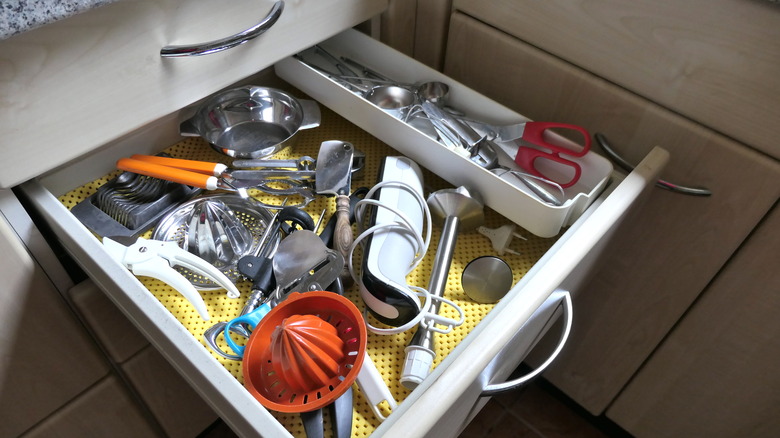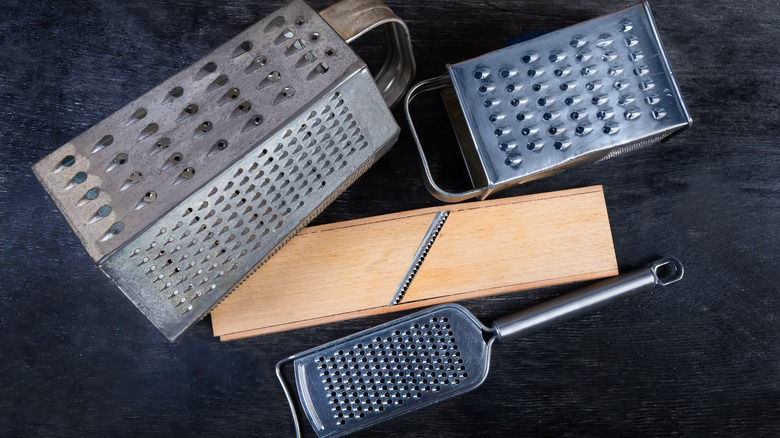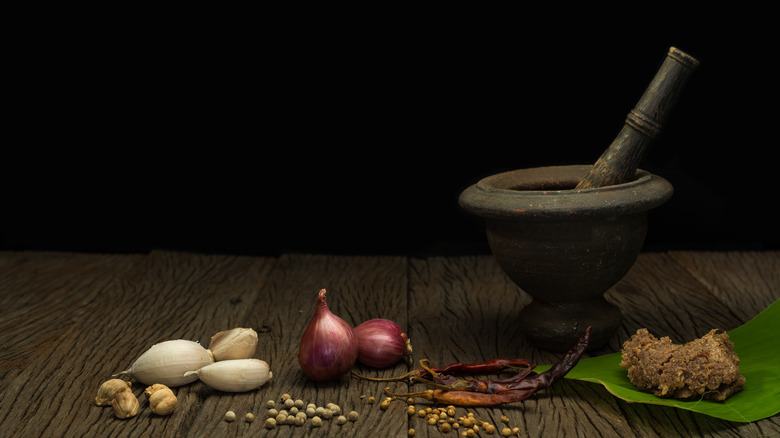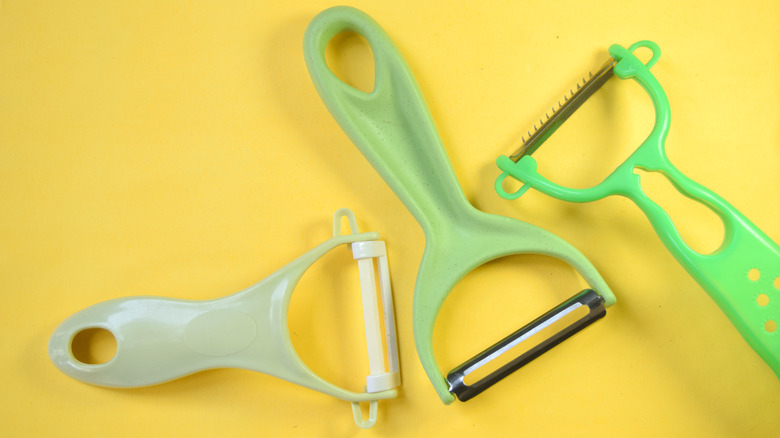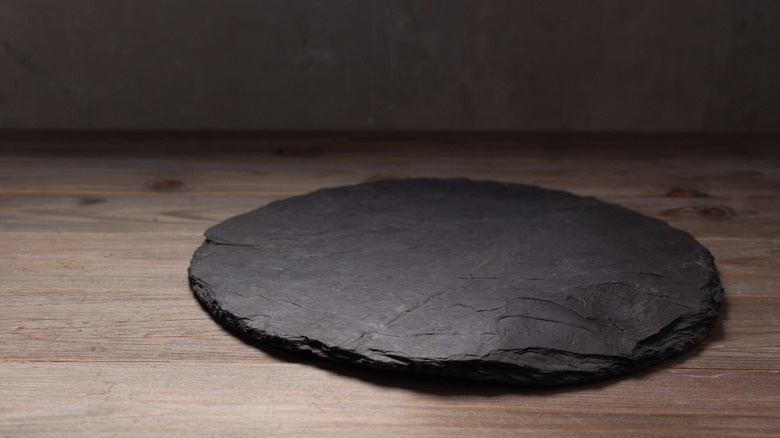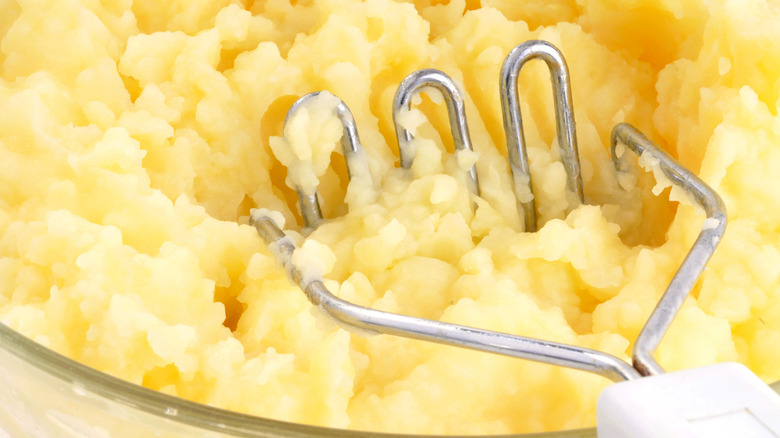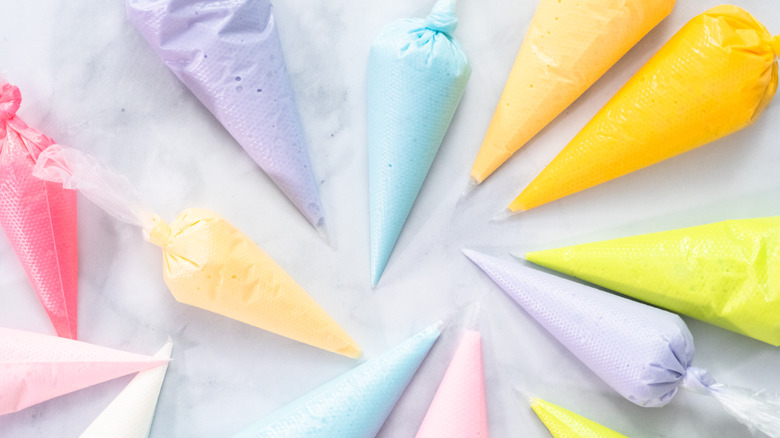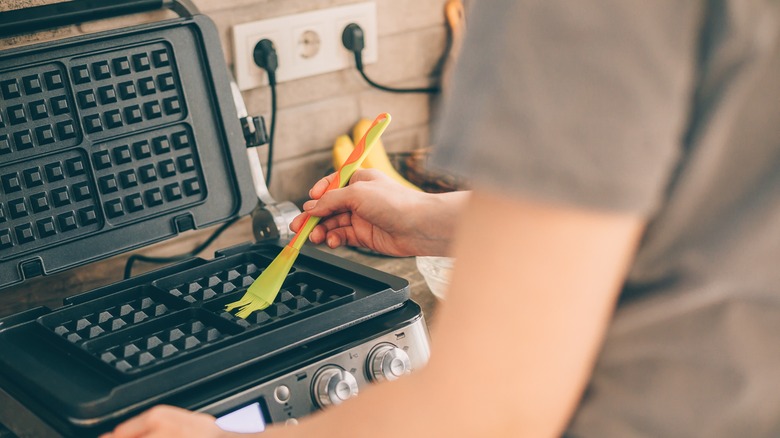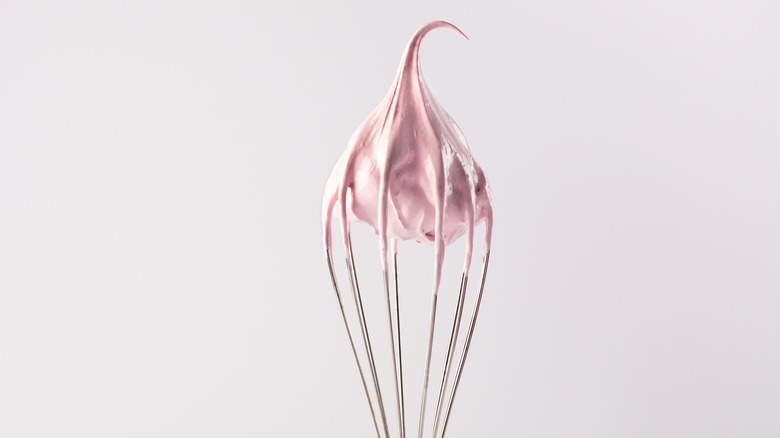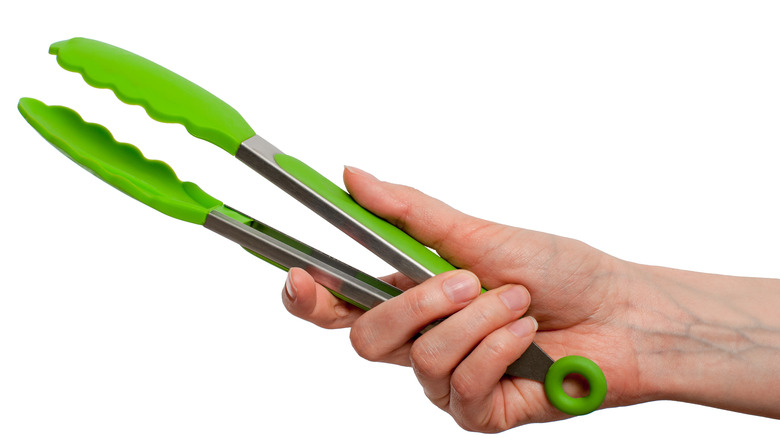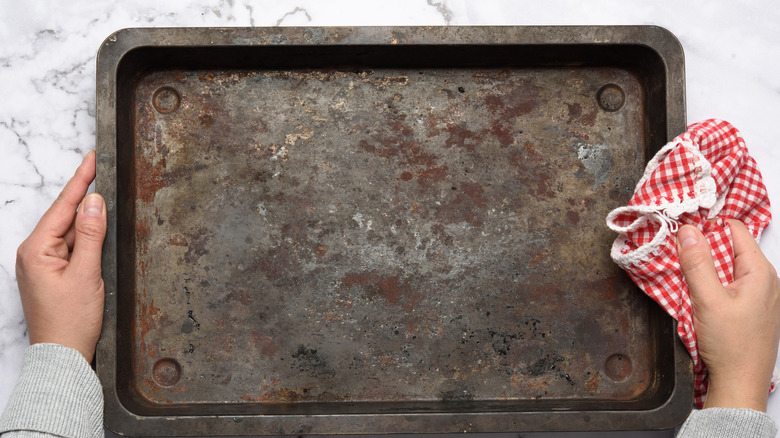10 Kitchen Tools You Should Be Using Differently
Any home chef has a collection of workhorse tools — their chef knives, their poultry shears, their mixer, and their blender. While the functions for these utensils are pretty straightforward, you'd be surprised at how many hidden uses there are for your old standbys. Most kitchen professionals will warn against single-use gadgets. Alton Brown is famously outspoken on his dislike of "unitaskers" (via NPR). Why waste precious drawer or countertop real estate on something that only serves a solitary purpose?
The simplest of tools can end up serving a myriad of uses, cutting down on clutter and the number of dishes you end up having to clean at the end of your project. Chances are you have all of these tools already in your arsenal, and by learning their hidden uses, you might even be able to donate all those one-trick ponies and free yourself up some space for even more kitchen activities.
Cheese graters can up your breadcrumb game
Whether you have a sturdy box grater or a slim-profile Microplane, most kitchens are not complete without a cheese grater. Who doesn't love a fresh shower of Parmesan floating down onto their pasta like delicate, salty snowflakes? The name of this tool explains its purpose, but it's always worth thinking outside of the box (grater) when it comes to versatility.
Box graters, as it turns out, can be your new best friend when it comes to making your own breadcrumbs. That last bit of garlic bread from last night's Italian take-out can be grated into a fine powder to bulk up tonight's meatloaf — no additional shopping trip required. Or, if you're cutting down on your Starbucks budget, you can use a cheese grater to shave chocolate or nutmeg onto your homemade coffee drinks. Step up your home-based barista game or add a fresh sprinkle of sweetness onto your ice cream without having to clutter your drawers with an extra implement.
A mortar and pestle will keep your fingers clean
There's something undeniably elemental about using a mortar and pestle in the kitchen. Nothing taps into your inner-kitchen witch quite like grinding your own peppercorns or spices. You're the Hecate of Hamburger Helper when you add in dashes of your own freshly cracked coriander. Of course, you might not find yourself reaching for this tool as often as you might like. But you might bring it into the standard rotation if it could prevent garlic smell from getting on your fingers. A few quick bashes with the pestle will get the papery outer layer off the garlic, and a few more will mash the garlic into a usable paste that can be added into almost any recipe, all without getting any of those stubborn, stinky oils on your fingers.
There are plenty of other uses for your mortar and pestle, including grinding fresh coffee — whether you just want enough for one cup at a time or you need a dash of espresso flavor for a chocolatey dessert recipe. When you don't want to wake up your roommates with the electric grinder at 6 a.m., go back to basics.
Vegetable peelers ensure picture perfect toast
No kitchen drawer is complete without a trusty vegetable peeler. Besides denuding potatoes and carrots, we might not give the humble vegetable peeler much further consideration. However, the thin blade actually is much handier than first meets the eye. How many mornings have you found yourself scraping cold butter across your freshly browned toast or bagel, only to tear up the delicious crust with the cold spread?
Instead of wrestling with a thick pat of cold butter, shave the butter with a vegetable peeler into thin, golden curls. These shavings will melt on the hot surface of the toast and spread so much easier, leaving your breakfast unmangled. As far as other uses for your vegetable peeler, you can also make chocolate curls by running your peeler along the side of a chocolate bar. Impress your friends with professional-grade dessert plates, or float a curl on the surface of a sweet cocktail for that immaculate finishing flourish.
Your pizza stone is the secret to quick chicken
The best thing about a pizza stone is that it can just hang out in your oven like a quiet, unobtrusive houseguest. It doesn't take up any extra space, even if you've cut down your pizza consumption from every other night to once or twice a month. You don't have to evict your best tenant just because you aren't heating up a pie as often as you used to.
A pizza stone is much more versatile than its name implies. It works by absorbing and concentrating the heat of the oven, giving pizza its delicious crisp crust. But did you know that a pizza stone is the key to perfect roast chicken thighs? When you place a sheet pan on a preheated pizza stone, it ensures a fast, even cook of the chicken. You can have delicious chicken in less than 10 minutes because the heat of the stone cooks the meat from the bottom in tandem with the heating element on top of the oven. This means your chicken stays juicy and you save time on your dinner prep. Win, win!
Potato mashers work for both meat and avocados
Mashed potatoes might just be the reigning king of side dishes. Ditching the dehydrating potato flakes for the real deal makes all the difference when it comes to flavor and texture, and having a trusty masher helps get those spuds to just the right consistency. Of course, you might not have the inclination to tackle mashed potatoes overnight, meaning that your masher might seem like a single-use artifact.
But potatoes aren't the only produce that benefits from a good smooshing. Turn to your masher for perfect guacamole, giving yourself the best ratio or smooth and chunky in half the time it would take you to use a smaller fork. You can also use this tool to break up ground meat for even cooking. Semi-thawed hamburger can be a pain to deal with when you're trying to get it spread out in a pan. A masher helps break up the chunks and ensure that everything cooks evenly with no raw-centered surprises.
Pastry bags maintain total control no matter what they dispense
Pastry bags are a staple for any serious baker. These simple plastic bags provide a huge amount of control when dispensing ingredients, which is why most bakers prefer to use them when frosting their desserts. However, you don't have to be the Cake Boss to find additional uses for pastry bags, either with or without the metal piping tips. On the savory end of the spectrum, you can fill deviled eggs easily using a bag and a tip. Having a perfect swirl on your yolk mix elevates your hors d'oeuvre to a classy level.
You can also pipe pancake batter directly onto a hot griddle to lessen the drippy mess a ladle would leave behind. You can also up your dessert game by using a pastry bag to fill your pastries and cupcakes. Add a metal tip to your pastry bag and poke it into your cupcake or donut to add a hidden gem of jam or cream and make sure that your pastry wins over every taster.
Waffle irons are good for breakfast and lunch
A waffle iron is such a fantastic, fun appliance to have in your kitchen. Nothing is more fun than whipping up a batch of golden waffles to smother in butter, syrup, and fruits for a weekend brunch. But after the waffle novelty wears off, you might be inclined to write off your griddle as a one-trick pony. That would be a serious mistake.
Your waffle iron has plenty of functions and doesn't have to be limited to sweet breakfast fare if you think outside the box. Spread frozen, shredded potatoes on the grill and make your own quick hash browns as the ultimate vehicle for over-easy eggs. Don't be afraid to use it later in the day, too. Use it to make perfectly toasty, melty paninis. Make sure that you butter the outside of the sandwich to get that to-die-for golden crust. You'll find yourself going back to the waffle maker again and age instead of firing up your stove.
Whisks make gorgeous sugar threads
Among the most basic of kitchen tools, the simple whisk gets overlooked for anything other than the most straightforward of uses. Of course, you can use it to make whipped cream from scratch and skip the canned "whipped topping." You can also mix together the dry ingredients when you're baking, eliminating the need to sift, which can get messy.
But perhaps the absolute best use for a whisk is to make spun sugar. First, you melt sugar into a liquid in a heavy-bottomed pot. While it's still hot, dip the whisk into the caramel and then drizzle the golden threads over your desserts. This is a way of creating a cage or threaded effect on your dishes, sending them over the top. Just be sure to be extra careful when you are working with melted sugar, as it can reach temperatures of over 367 degrees F (per Scientific American).
Tongs can help you get the most out of citrus
In a professional kitchen, a sturdy pair of tongs are the extension of the line cook's hand. They're used to turn meat on the grill, move food from the stove to the plate, and arrange the food to ensure it looks amazing while maintaining sanitation practices. But tongs aren't just for grabbing.
In fact, a whole new world opens up when you change your perspectives on how you even hold a pair of tongs. Juicing citrus is a breeze with tongs. If you place a halved citrus fruit between the handles of the tongs and squeeze the ends, you get so much more juice than you would by just squeezing with your hands. You can also use the handles of tongs as an impromptu bottle opener, using the leverage that the handles give you to pop the top off of even the most stubborn bottle of beer.
Sheet pans keep mess contained and make for attractive presentation
Talk about a workhorse — your standard sheet pan probably does just as much work as all the rest of your kitchen utensils and tools combined. From baking cookies to one-pan meals, it can seem like a sheet pan never runs out of uses. But in case you wanted to add a few more tricks to this standby's repertoire, you can use a sheet pan to catch vegetables while you're chopping. Put a sheet pan under your cutting board while you're prepping and wheels of cucumbers or kernels of corn that might otherwise escape and end up on the floor will stay contained. Less mess, less waste.
You can also take a rustic turn in your charcuterie presentation by serving your nibbles on a sheet pan at your next get-together. You don't have to splurge on a fancy serving platter, and it provides plenty of space for making an artistic spread.
